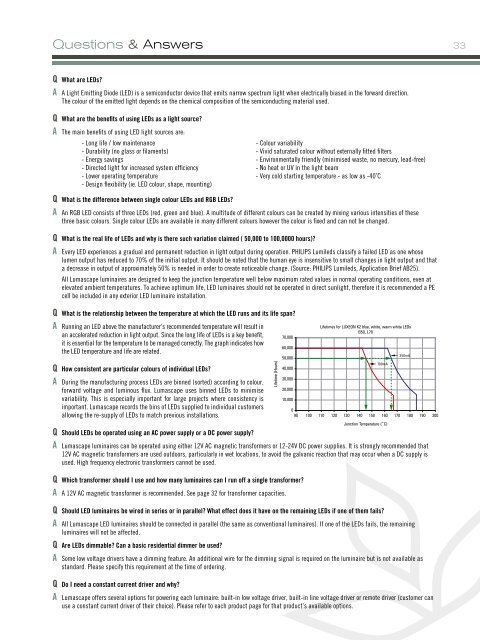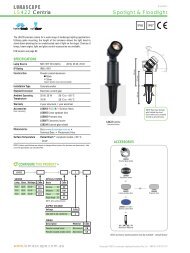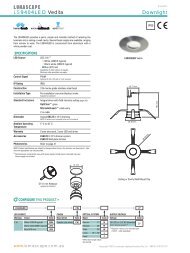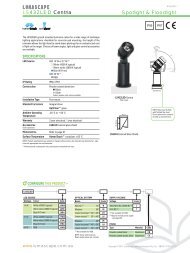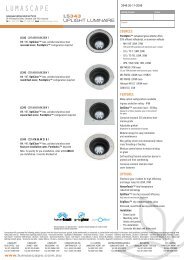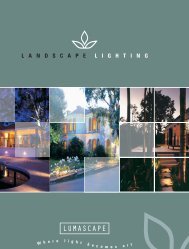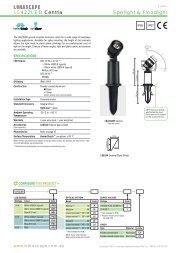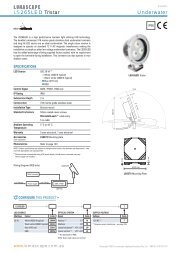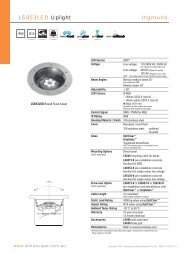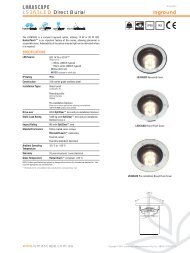LSPROM106 - LS LED Product Catalogue 2008.pdf - Lumascape
LSPROM106 - LS LED Product Catalogue 2008.pdf - Lumascape
LSPROM106 - LS LED Product Catalogue 2008.pdf - Lumascape
- No tags were found...
You also want an ePaper? Increase the reach of your titles
YUMPU automatically turns print PDFs into web optimized ePapers that Google loves.
Questions & Answers33Q What are <strong>LED</strong>s?A A Light Emitting Diode (<strong>LED</strong>) is a semiconductor device that emits narrow spectrum light when electrically biased in the forward direction.The colour of the emitted light depends on the chemical composition of the semiconducting material used.Q What are the benefits of using <strong>LED</strong>s as a light source?A The main benefits of using <strong>LED</strong> light sources are:- Long life / low maintenance - Colour variability- Durability (no glass or filaments) - Vivid saturated colour without externally fitted filters- Energy savings - Environmentally friendly (minimised waste, no mercury, lead-free)- Directed light for increased system efficiency - No heat or UV in the light beam- Lower operating temperature - Very cold starting temperature - as low as -40˚C- Design flexibility (ie. <strong>LED</strong> colour, shape, mounting)Q What is the difference between single colour <strong>LED</strong>s and RGB <strong>LED</strong>s?A An RGB <strong>LED</strong> consists of three <strong>LED</strong>s (red, green and blue). A multitude of different colours can be created by mixing various intensities of thesethree basic colours. Single colour <strong>LED</strong>s are available in many different colours however the colour is fixed and can not be changed.Q What is the real life of <strong>LED</strong>s and why is there such variation claimed ( 50,000 to 100,0000 hours)?A Every <strong>LED</strong> experiences a gradual and permanent reduction in light output during operation. PHILIPS Lumileds classify a failed <strong>LED</strong> as one whoselumen output has reduced to 70% of the initial output. It should be noted that the human eye is insensitive to small changes in light output and thata decrease in output of approximately 50% is needed in order to create noticeable change. (Source: PHILIPS Lumileds, Application Brief AB25).All <strong>Lumascape</strong> luminaires are designed to keep the junction temperature well below maximum rated values in normal operating conditions, even atelevated ambient temperatures. To achieve optimum life, <strong>LED</strong> luminaires should not be operated in direct sunlight, therefore it is recommended a PEcell be included in any exterior <strong>LED</strong> luminaire installation.Q What is the relationship between the temperature at which the <strong>LED</strong> runs and its life span?A Running an <strong>LED</strong> above the manufacturer’s recommended temperature will result inan accelerated reduction in light output. Since the long life of <strong>LED</strong>s is a key benefit,it is essential for the temperature to be managed correctly. The graph indicates howthe <strong>LED</strong> temperature and life are related.Q How consistent are particular colours of individual <strong>LED</strong>s?A During the manufacturing process <strong>LED</strong>s are binned (sorted) according to colour,forward voltage and luminous flux. <strong>Lumascape</strong> uses binned <strong>LED</strong>s to minimisevariability. This is especially important for large projects where consistency isimportant. <strong>Lumascape</strong> records the bins of <strong>LED</strong>s supplied to individual customersallowing the re-supply of <strong>LED</strong>s to match previous installations.Q Should <strong>LED</strong>s be operated using an AC power supply or a DC power supply?A <strong>Lumascape</strong> luminaires can be operated using either 12V AC magnetic transformers or 12-24V DC power supplies. It is strongly recommended that12V AC magnetic transformers are used outdoors, particularly in wet locations, to avoid the galvanic reaction that may occur when a DC supply isused. High frequency electronic transformers cannot be used.Q Which transformer should I use and how many luminaires can I run off a single transformer?A A 12V AC magnetic transformer is recommended. See page 32 for transformer capacities.Q Should <strong>LED</strong> luminaires be wired in series or in parallel? What effect does it have on the remaining <strong>LED</strong>s if one of them fails?A All <strong>Lumascape</strong> <strong>LED</strong> luminaires should be connected in parallel (the same as conventional luminaires). If one of the <strong>LED</strong>s fails, the remainingluminaires will not be affected.Q Are <strong>LED</strong>s dimmable? Can a basic residential dimmer be used?A Some low voltage drivers have a dimming feature. An additional wire for the dimming signal is required on the luminaire but is not available asstandard. Please specify this requirement at the time of ordering.Q Do I need a constant current driver and why?A <strong>Lumascape</strong> offers several options for powering each luminaire: built-in low voltage driver, built-in line voltage driver or remote driver (customer canuse a constant current driver of their choice). Please refer to each product page for that product’s available options.Lifetime (Hours)70,00060,00050,00040,00030,00020,00010,000Lifetimes for LUXEON K2 blue, white, warm white <strong>LED</strong>sB50, L70700mA090 100 110 120 130 140 150 160 170 180 190 200Junction Temperature (˚C)350mALifetime (Hours)70,00060,00050,00040,00030,00020,00010,000050


